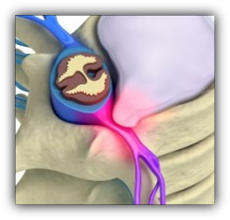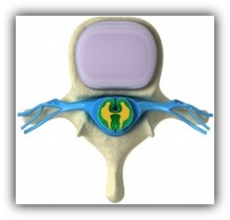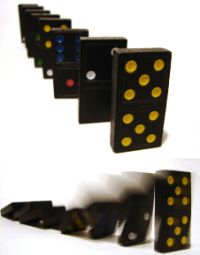




BODY NERVE FLOW IS REDUCED BY SUBLUXATIONS
Subluxations
First, Let's Keep It Simple. A vertebral subluxation occurs when the joints of the spine fail to move properly due to spinal misalignments; causing interference with the nerve messages from the brain to the body and/or from the body to the brain. This fixation, or loss of normal motion, can affect movement patterns, muscle balance, and even reduce the function of organs and the chemicals and hormones they produce. A vertebral subluxation, is the impairment of optimal expression of your nervous system caused by physical, biochemical or psychological distress.
In a properly functioning spine, the twenty four vertebrae plus the sacrum and coccyx bone, normally stack on top of one another in a centered and balanced alignment. When a subluxation is present, the misaligned vertebra place pressure on the delicate spinal nerves as they exit, causing irritation and a decrease in their function. The best visual explanation of the nerve pressure that occurs with a vertebral subluxation is to think about a garden hose. Without a kink, the water flows normally and easily, but if you bend the hose the flow of water begins to slow. If you bend the hose even harder, the water pressure continues slowing until there is just a trickle coming out. In this scenario, the hose represents the spinal nerves, the water represents the flowing nerve signals and impulses and the kink represents the spinal subluxation. Picture how healthy your garden would be if the hose serving it only produced a trickle of water. Now imagine how a vertebral subluxation can affect overall health by reducing nerve impulse and function.
The term "vertebral subluxation" is at the core of chiropractic care. While many other terms have been used to describe aspects of this condition, such as spinal misalignment, fixation, spinal dysfunction, facet syndrome or manipulable lesion; these synonyms are overly mechanical and fall short of describing the true nature, complexity and overall health implications of the vertebral subluxation. The role of a chiropractic doctor is to locate, reduce and correct spinal subluxations. This is done through a series of chiropractic adjustments or manipulations, specifically designed to correct subluxations of the spine. Chiropractors spend many years studying and training to become masters of correcting vertebral subluxations.

The five components of the VSC work in a manner very similar to the Domino Effect.
Let's Dig A Little Deeper To Understand Vertebral Subluxation Further. There has been a wealth of knowledge accumulated over the past few decades that has proven the bone pressing on a nerve concept of vertebral subluxation to be too simplistic. Science, in fact, has discovered that there is actually a multitude of damaging effects taking place and this degenerative process is referred to as the vertebral subluxation complex (VSC). It has been accepted that the vertebral subluxation complex actually involves five separate damaging processes that facilitate dramatic changes in bodily function. From a contemporary scientific chiropractic point of view, the vertebral subluxation complex is a dynamic process involving several tissue levels and integrative components.
The combinations of these VSC components interfere with the ability of the nervous system to control and coordinate all the functions of your body. The five components of the VSC work in a manner very similar to the Domino Effect. The domino effect is a chain reaction that occurs when a small change causes a similar change nearby, which then will cause another similar change and so on in linear sequence. The classic demonstration involves setting up a chain of dominoes stood on end and toppling the first domino. That first domino falls and topples the domino next to it and so on. In theory, however long the chain, the dominoes will still fall. This is because the energy required to topple each domino is less than the energy transferred by each impact, so the chain is self-sustaining. Be careful, because when that first subluxation domino falls, it begins a cascade of ill health. Below you can learn about the five components of this complex that may be silently developing in you.
The Bone Component
The first domino of the vertebral subluxation complex is the development of abnormal motion or positioning of the spinal bones; better known as spinal kinesiopathology. A spine out of proper alignment results in uneven wear and tear on the spinal joints and causes changes in joint motion. As a result, the joint may move too much and be hyper-mobile, be hypo-mobile and have little mobility or be fixated and have no movement at all. All of these scenarios will ultimately lead to some degree of degenerative damage to the overall joint structure. Spinal kinesiopathology, left unattended, sets in motion the other four components. This is no different than your car tires being out of alignment. Without proper alignment, the tires wear unevenly and inevitable lead to other problems as a result of the car driving improperly. Now the chain reaction of the subluxation dominos begins!
The Nerve Component
This part of the subluxation process is known as neuropathophysiology and is caused by improper spinal function that chokes, stretches or irritates the delicate nerve tissue as it exits the spine. Changes in vertebral movement or position can alter the shape or size of the spinal canal and intervertebral foramen; the space that the spinal cord and spinal nerves travel through in the spine. This results in deficient nerve transmission and function. Research has shown that the weight of a dime is all the pressure needed to reduce the transmission rate of spinal nerves by as much as sixty percent. This reduction and altered nerve function to the spinal muscles, causes the third subluxation domino to come into play.
The Muscle Component
Abnormal muscle function of the spine is referred to as spinal myopathology and is also caused by irregular vertebral motion or positioning along with its associated nerve interference. The altered state of the vertebra and neural impulses can cause the muscles supporting the spine to become weakened, atrophied or so tight they go into a state of constant spasm. As a result, the muscle fibers begin to break down and the muscle is infiltrated by scar tissue, called fibrosis. The resulting scar tissue is no different than the gristle in a cheap, low quality cut of meat. The scarred muscle is less elastic and flexible and develops a reduced ability to adapt and respond to any changes in workload. Once this scar tissue has taken hold, you have a problem, both structurally and functionally, that will begin to cause the fourth subluxation domino to become unsteady and the entire joint itself is now susceptible to damage.
The Soft Tissue And Overall Joint Dysfunction Component
Abnormal joint function is referred to as histopathology. If you have reached this point, the problem has now progressed to pathological changes that may affect spinal joint tissues. Bone deterioration of the vertebral bodies, fibrosis and adhesions of spinal muscles and ligaments, as well as dehydration and degeneration of spinal discs may develop. Our joints get hydration from quality movement much like a sponge. Without hydration, our joints become brittle and subject to injury. Unfortunately, discs are poorly supplied with blood and nutrients and can not reabsorb lost fluids as well as a sponge. Lost motion combined with a decreased re-absorption rate, often causes the discs and ligaments to become brittle and lose their limited elasticity; further contributing to the reduction of spinal joint mobility. As the joint becomes increasingly dysfunctional and unstable, the final subluxation domino begins to fall.
The Biological Chemical Component
The fifth subluxation domino is referred to as pathophysiology. If this domino falls, the spine is essentially falling apart and will begin to break down structurally. Long term swelling of spinal structures, such as ligaments, disks and other soft tissues, cause a loss of function in the joints. Now the body's natural biological defense mechanisms kick in and attempt to minimize the damage. At this stage, irreversible disease or pathology can occur. Calcium is deposited in the affected joints and bone spur formations begin, called osteophystosis or more commonly, degenerative arthritis. As spurs develop on the vertebrae, joint motion is further reduced and the spurs begin to fuse together as the degenerative process unfolds. The body is literally trying to fuse the affected joint(s) in an effort to prevent any further damage to its communication network; the nerve system. Just like the fallen dominos, if the spine is injured and left to fend for itself, it will eventually fuse together as the body's defensive response to chronic vertebral subluxation complex takes effect.
Ironically, subluxation is similar to dental cavities; in both cases a significant amount of damage is done before the pain arises. Seek periodic spinal checkups by a chiropractic doctor to assess for subluxation. A good chiropractor will treat not only the symptoms, but also the root cause for the vertebral subluxation. Apart from treatment, and with your chiropractors advice, you can make changes to your lifestyle so that future instances of vertebral subluxation can be avoided and save yourself from pain.





POSTED PROVISIONS


PARENT COMPANY
EVERYBODIES DIRECTORIES™
FAX NO: 1-314-480-7068

TOLL FREE: 1-866-515-9991
COPYRIGHT 2006 - 2012 EVERYBODIESCHIROPRACTOR.COM©. ALL RIGHTS RESERVED.












































































